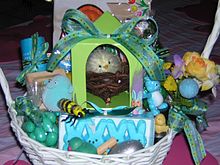
Easter eggs, also called Paschal eggs, are eggs that are decorated for the Christian holiday of Easter, which celebrates the resurrection of Jesus. As such, Easter eggs are commonly used during the season of Eastertide. The oldest tradition, which continues to be used in Central and Eastern Europe, is to dye and paint chicken eggs.

Great Lent, or the Great Fast, is the most important fasting season of the church year within many denominations of Eastern Christianity. It is intended to prepare Christians for the greatest feast of the church year, Pascha (Easter).

The Easter Bunny is a folkloric figure and symbol of Easter, depicted as a rabbit—sometimes dressed with clothes—bringing Easter eggs. Originating among German Lutherans, the "Easter Hare" originally played the role of a judge, evaluating whether children were good or disobedient in behavior at the start of the season of Eastertide, similar to the "naughty or nice" list made by Santa Claus. As part of the legend, the creature carries colored eggs in its basket, as well as candy, and sometimes toys, to the homes of children. As such, the Easter Bunny again shows similarities to Santa and Christmas by bringing gifts to children on the night before a holiday. The custom was first mentioned in Georg Franck von Franckenau's De ovis paschalibus in 1682, referring to a German tradition of an Easter Hare bringing eggs for the children.

Shrove Tuesday is the final day of Shrovetide, marking the end of pre-Lent. Lent begins the following day with Ash Wednesday. Shrove Tuesday is observed in many Christian countries through participating in confession; the ritual burning of the previous year's Holy Week palms; finalizing one's Lenten sacrifice; as well as eating pancakes and other sweets.

Ash Wednesday is a holy day of prayer and fasting in many Western Christian denominations. It is preceded by Shrove Tuesday and marks the first day of Lent, the six weeks of penitence before Easter.

Holy Week includes the events of Jesus Christ's entry into Jerusalem, the last supper, the arrest, and his death by crucifixion. For all Christian traditions, it is a moveable observance. In Eastern Christianity, which also calls it Great Week, it is the week following Great Lent and Lazarus Saturday, starting on the evening of Palm Sunday and concluding on the evening of Great Saturday. In Western Christianity, Holy Week is the sixth and last week of Lent, beginning with Palm Sunday and concluding on Holy Saturday.

Holy Saturday, also known as Great and Holy Saturday, Low Saturday, the Great Sabbath, Hallelujah Saturday, Saturday of the Glory, Sábado de Gloria, and Black Saturday or Easter Eve, and called "Joyous Saturday", "the Saturday of Light", and "Mega Sabbatun" among Coptic Christians, is the final day of Holy Week, between Good Friday and Easter Sunday, when Christians prepare for the latter.

Egg rolling, or an Easter egg roll is a traditional game played with eggs at Easter. Different nations have different versions of the game, usually played with hard-boiled, decorated eggs.

The Friday fast is a Christian practice of variously abstaining from meat, dairy products and alcohol, on Fridays, or holding a fast on Fridays, that is found most frequently in the Eastern Orthodox, Oriental Orthodox, Catholic, Lutheran, Anglican and Methodist traditions. The Teaching of the Twelve Apostles, written in the first century A.D., directed Christians to fast on both Wednesdays and Fridays. The Wednesday fast is done in remembrance of the story of the betrayal of Christ by Judas on Spy Wednesday, while the Friday fast is done in commemoration of the crucifixion of Jesus Christ on Good Friday. As such, all Fridays of the year have been historically kept in many parts of Christendom as a day of strict fasting and abstinence from alcohol, meat and lacticinia. Abstinence from meat on Fridays is done as a sacrifice by many Christians because they believe that on Good Friday, Jesus sacrificed his flesh for humanity. In the Eastern Orthodox Church, in addition to fasting from food until sundown, the faithful are enjoined to abstain from sexual relations on Fridays as well.

Święconka, meaning "the blessing of the Easter baskets", is one of the most enduring and beloved Polish traditions on Holy Saturday during Easter. With roots dating back to the early history of Poland, it is also observed by expatriate and their descendants Poles in the United States, Canada, the United Kingdom, Ireland, Sweden and other Polish communities in the world.

Egg tossing or egg throwing is a game associated with Easter. Various types of such games exist, common ones involve throwing an egg so that it lands on the ground without breaking. Such a contest may be known as an egg toss.
Abstinence is the practice of self-enforced restraint from indulging in bodily activities that are widely experienced as giving pleasure. Most frequently, the term refers to sexual abstinence, but it can also mean abstinence from alcohol, drugs, food, or other comforts.

Lent is the solemn Christian religious observance in the liturgical year commemorating the 40 days Jesus spent fasting in the desert and enduring temptation by Satan, according to the Gospels of Matthew, Mark and Luke, before beginning his public ministry. Lent is usually observed in the Catholic, Lutheran, Moravian, Anglican, United Protestant and Orthodox Christian traditions, among others. Some Anabaptist, Baptist, Methodist, Reformed, and nondenominational Christian churches also observe Lent, although many churches in these traditions do not.

A German tradition of decorating trees and bushes with Easter eggs is known as the Ostereierbaum, or Easter egg tree. A notable example is the Saalfelder Ostereierbaum in Saalfeld, Thuringia.

The holiday of Easter is associated with various Easter customs and foodways. Preparing, coloring, and decorating Easter eggs is one such popular tradition. Lamb is eaten in many countries, mirroring the Jewish Passover meal.
Christian dietary laws vary between denominations. The general dietary restrictions specified for Christians in the New Testament are to "abstain from food sacrificed to idols, from blood, from meat of strangled animals". Some Christian denominations forbid certain foods during periods of fasting, which in some cases may cover half the year and may exclude meat, fish, dairy products, and olive oil.

A Lenten sacrifice is a spiritual practice where Christians, particularly Catholics, Lutherans, Anglicans, Methodists, Moravians and the United Protestants voluntarily renounce a pleasure or luxury during the observance of Lent, which begins on Ash Wednesday. The tradition of Lent has its roots in Jesus Christ praying and fasting for forty days in the desert according to the gospels of Matthew, Mark and Luke. When Lent is over and Easter Sunday arrives, the faithful are able to indulge in what they sacrificed during the Lenten season.

A Lenten supper is a meal that takes place in the evenings to break the day's fast during the Christian liturgical season of Lent, which is widely observed by members of the Catholic, Lutheran, Moravian, Anglican, Methodist, and United Protestant traditions, in addition to certain Reformed denominations.
Fasting is practiced in various religions. Examples include Lent in Christianity and Yom Kippur, Tisha B'av, Fast of Esther, Fast of Gedalia, the Seventeenth of Tammuz, and the Tenth of Tevet in Judaism. Muslims fast during the month of Ramadan each year. The fast includes refraining from consuming any food or liquid from sunup until sundown.

Shrovetide is the Christian liturgical period prior to the start of Lent that begins on Shrove Saturday and ends at the close of Shrove Tuesday. The season focuses on examination of conscience and repentance before the Lenten fast. It includes Shrove Saturday, Shrove Sunday, Shrove Monday and Shrove Tuesday.



















